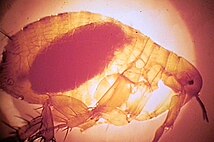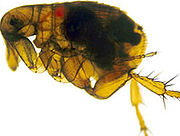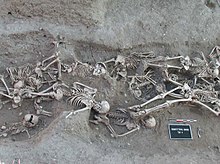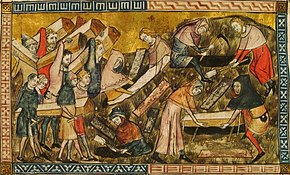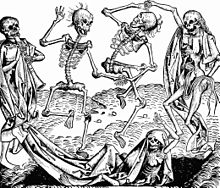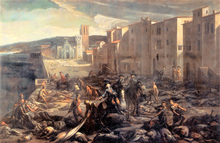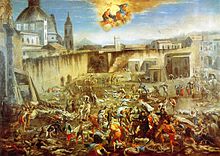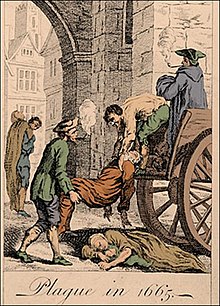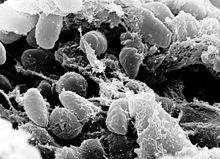Spread of the Black Death in Europe and the Near East (1346–1353)
The Black Death, also known as the Pestilence, Great Bubonic Plague, the Great Plague or the Plague, or less commonly the Great Mortality or the Black Plague, was the most devastating pandemic recorded in human history, resulting in the deaths of an estimated 75 to 200 million people in Eurasia, peaking in Europe from 1347 to 1351. The bacterium Yersinia pestis, which results in several forms of plague (septicemic, pneumonic and, the most common, bubonic), is believed to have been the cause. The Black Death was the first major European outbreak of plague and the second plague pandemic.
The plague created a number of religious, social and economic
upheavals, with profound effects on the course of European history.
The Black Death probably originated in Central Asia or East Asia, from where it travelled along the Silk Road, reaching Crimea by 1343. From there, it was most likely carried by fleas living on the black rats that traveled on Genoese merchant ships, spreading throughout the Mediterranean Basin, reaching the rest of Europe via the Italian peninsula.
The Black Death is estimated to have killed 30% to 60% of Europe's population. In total, the plague may have reduced the world population from an estimated 475 million to 350–375 million in the 14th century. It took 200 years for Europe's population to recover to its previous level, and some regions (such as Florence) only recovered by the 19th century. Outbreaks of the plague recurred until the early 20th century.
Names
The phrase "black death" (mors nigra)
was used in 1350 by Simon de Covino or Couvin, a Belgian astronomer,
who wrote the poem "On the Judgment of the Sun at a Feast of Saturn" (De judicio Solis in convivio Saturni), which attributes the plague to a conjunction of Jupiter and Saturn.
In 1908, Gasquet claimed that use of the name atra mors for the 14th-century epidemic first appeared in a 1631 book on Danish history by J. I. Pontanus: "Commonly and from its effects, they called it the black death" (Vulgo & ab effectu atram mortem vocitabant).
The name spread through Scandinavia and then Germany, gradually
becoming attached to the mid 14th-century epidemic as a proper name.
However, atra mors is used to refer to a pestilential fever (febris pestilentialis) already in the 12th-century On the Signs and Symptoms of Diseases (Latin: De signis et sinthomatibus egritudinum) by French physician Gilles de Corbeil. In English, the term was first used in 1755. Writers contemporary with the plague described the event as "great plague" or "great pestilence".
Chronology
Origins
The plague disease, caused by Yersinia pestis, is enzootic (commonly present) in populations of fleas carried by ground rodents, including marmots, in various areas, including Central Asia, Kurdistan, Western Asia, North India, and Uganda. Due to climate change in Asia, rodents began to flee the dried-out grasslands to more populated areas, spreading the disease. In October 2010, medical geneticists suggested that all three of the great waves of the plague originated in China. Research in 2017 concerning Nestorian graves dating to 1338–1339 near Issyk-Kul in Kyrgyzstan that have inscriptions referring to plague, has led many epidemiologists to think they mark the outbreak of the epidemic; from which it could easily have spread to China and India.
Research in 2018 found evidence of Yersinia pestis in an ancient Swedish tomb, which may have been the cause of what has been described as the Neolithic decline around 3000 BC, in which European populations declined significantly. In 2013, researchers confirmed earlier speculation that the cause of the Plague of Justinian (541–542 AD, with recurrences until 750) was Yersinia pestis.
The 13th-century Mongol conquest of China
caused a decline in farming and trading. Economic recovery had been
observed at the beginning of the fourteenth century. In the 1330s, many
natural disasters and plagues led to widespread famine, starting in
1331, with a deadly plague arriving soon after.
Epidemics, that may have included the plague, killed an estimated
25 million across Asia during the fifteen years before it reached Constantinople in 1347.
The disease may have traveled along the Silk Road with Mongol armies and traders, or it could have arrived via ship. By the end of 1346, reports of plague had reached the seaports of Europe: "India was depopulated, Tartary, Mesopotamia, Syria, Armenia were covered with dead bodies".
Plague was reportedly first introduced to Europe via Genoese traders from the port city of Kaffa in the Crimea in 1347. During a protracted siege of the city by the Mongol army under Jani Beg, whose army was suffering from the disease, the army catapulted infected corpses over the city walls of Kaffa to infect the inhabitants. The Genoese traders fled, taking the plague by ship into Sicily, then the Italian mainland, whence it spread north.
Whether or not this hypothesis is accurate, it is clear that several
existing conditions, such as war, famine, and weather, contributed to
the severity of the Black Death. Among many other culprits of plague
contagiousness, malnutrition, even if distantly, also contributed to
such an immense loss in European population, since it weakened immune
systems.
European outbreak
The seventh year after it began, it came to England and first began in the towns and ports joining on the seacoasts, in Dorsetshire, where, as in other counties, it made the country quite void of inhabitants so that there were almost none left alive.... But at length it came to Gloucester, yea even to Oxford and to London, and finally it spread over all England and so wasted the people that scarce the tenth person of any sort was left alive.--Geoffrey the Baker, Chronicon Angliae
There appear to have been several introductions into Europe. The
plague reached Sicily in October 1347, carried by twelve Genoese
galleys, and rapidly spread all over the island. Galleys from Kaffa reached Genoa and Venice in January 1348, but it was the outbreak in Pisa
a few weeks later that was the entry point to northern Italy. Towards
the end of January, one of the galleys expelled from Italy arrived in Marseille.
From Italy, the disease spread northwest across Europe, striking
France, Spain (which was hit due to the heat – the epidemic raged in the
early weeks of July),
Portugal and England by June 1348, then spread east and north through
Germany, Scotland and Scandinavia from 1348 to 1350. It was introduced
into Norway in 1349 when a ship landed at Askøy, then spread to Bjørgvin (modern Bergen) and Iceland.
Finally, it spread to northwestern Russia in 1351. The plague was
somewhat more uncommon in parts of Europe with less developed trade with
their neighbours, including the majority of the Basque Country, isolated parts of Belgium and the Netherlands, and isolated alpine villages throughout the continent.
According to some epidemiologists, periods of unfavorable weather
decimated plague-infected rodent populations and forced their fleas
onto alternative hosts, inducing plague outbreaks which often peaked in the hot summers of the Mediterranean, as well as during the cool autumn months of the southern Baltic states.
However, other researchers do not think that the plague ever became
endemic in Europe or its rat population. The disease repeatedly wiped
out the rodent carriers, so that the fleas died out until a new outbreak
from Central Asia repeated the process. The outbreaks have been shown
to occur roughly 15 years after a warmer and wetter period in areas
where plague is endemic in other species, such as gerbils.
Middle Eastern outbreak
The plague struck various regions in the Middle East during the pandemic,
leading to serious depopulation and permanent change in both economic
and social structures. It may have spread from Central Asia with the Mongols to a trading post in Crimea, called Kaffa, controlled by the Republic of Genoa.
As infected rodents infected new rodents, the disease spread across the
region, including South Africa entering also from southern Russia. By
autumn 1347, the plague reached Alexandria in Egypt, through the port's trade with Constantinople, and ports on the Black Sea. During 1347, the disease travelled eastward to Gaza, and north along the eastern coast to cities in modern Lebanon, Syria, Israel and Palestine, including Ashkelon, Acre, Jerusalem, Sidon, Damascus, Homs, and Aleppo. Within two years, the plague had spread throughout the entire Muslim empire from Arabia across North Africa. In 1348–1349, the disease reached Antioch. The city's residents fled to the north, but most of them ended up dying during the journey.
Mecca became infected in 1349. During the same year, records show the city of Mosul suffered a massive epidemic, and the city of Baghdad experienced a second round of the disease.
Muslim religious scholars taught that the plague was a “martyrdom
and mercy” from God, assuring the believer's place in paradise. For
non-believers, it was a punishment.
Some Muslim doctors cautioned against trying to prevent or treat a
disease sent by God. Others adopted many of the same preventive measures
and treatments for the plague used by the Europeans. These Muslim
doctors also depended on the writings of the ancient Greeks.
Signs and symptoms
An inguinal bubo on the upper thigh of a person infected with bubonic plague. Swollen lymph nodes (buboes) often occur in the neck, armpit and groin (inguinal) regions of plague victims.
Contemporary accounts of the plague are often varied or imprecise. The most commonly noted symptom was the appearance of buboes (or gavocciolos) in the groin, the neck and armpits, which oozed pus and bled when opened. Boccaccio's description:
In men and women alike it first betrayed itself by the emergence of certain tumours in the groin or armpits, some of which grew as large as a common apple, others as an egg ... From the two said parts of the body this deadly gavocciolo soon began to propagate and spread itself in all directions indifferently; after which the form of the malady began to change, black spots or livid making their appearance in many cases on the arm or the thigh or elsewhere, now few and large, now minute and numerous. As the gavocciolo had been and still was an infallible token of approaching death, such also were these spots on whomsoever they showed themselves.
The only medical detail that is questionable in Boccaccio's
description is that the gavocciolo was an "infallible token of
approaching death", as, if the bubo discharges, recovery is possible.
This was followed by acute fever and vomiting of blood. Most victims died two to seven days after initial infection. Freckle-like spots and rashes, which could have been caused by flea-bites, were identified as another potential sign of the plague.
Some accounts, like that of Lodewijk Heyligen, whose master the Cardinal Colonna died of the plague in 1348, noted a distinct form of the disease that infected the lungs and led to respiratory problems and is identified with pneumonic plague.
It is said that the plague takes three forms. In the first people suffer an infection of the lungs, which leads to breathing difficulties. Whoever has this corruption or contamination to any extent cannot escape but will die within two days. Another form ... in which boils erupt under the armpits, ... a third form in which people of both sexes are attacked in the groin.
Causes
The Oriental rat flea (Xenopsylla cheopis) engorged with blood. This species of flea is the primary vector for the transmission of Yersinia pestis, the organism responsible for spreading bubonic plague in most plague epidemics. Both male and female fleas feed on blood and can transmit the infection.
Oriental rat flea (Xenopsylla cheopis) infected with the Yersinia pestis bacterium which appears as a dark mass in the gut. The foregut (proventriculus) of this flea is blocked by a Y. pestis biofilm; when the flea feeds on an uninfected host Y. pestis is regurgitated into the wound, causing infection.
Yersinia pestis (200× magnification), the bacterium which causes bubonic plague
Medical knowledge had stagnated during the Middle Ages. The most authoritative account at the time came from the medical faculty in Paris in a report to the king of France that blamed the heavens, in the form of a conjunction of three planets in 1345 that caused a "great pestilence in the air".
This report became the first and most widely circulated of a series of
plague tracts that sought to give advice to sufferers. That the plague
was caused by bad air became the most widely accepted theory at the
time, the miasma theory. The word plague
did not at first refer to a specific illness, and only the recurrence
of outbreaks during the Middle Ages gave it the meaning which persists
in modern medicine.
The importance of hygiene
was recognised only in the nineteenth century; until then streets were
commonly filthy, with live animals of all sorts around and human
parasites abounding, facilitating the spread of transmissible disease. One early medical advance as a result of the Black Death was the establishment of the idea of quarantine in the city-state of Ragusa (modern Dubrovnik, Croatia) in 1377 after continuing outbreaks.
Today, the dominant explanation for the Black Death is the plague theory, which attributes the outbreak to Yersinia pestis,
also responsible for an epidemic that began in southern China in 1865,
eventually spreading to India. The investigation of the pathogen that
caused the 19th-century plague was begun by teams of scientists who
visited Hong Kong in 1894, among whom was the French-Swiss
bacteriologist Alexandre Yersin, after whom the pathogen was named. The mechanism by which Y. pestis is usually transmitted was established in 1898 by Paul-Louis Simond and was found to involve the bites of fleas whose midguts had become obstructed by replicating Y. pestis
several days after feeding on an infected host. This blockage starves
the fleas and drives them to aggressive feeding behaviour and attempts
to clear the blockage by regurgitation,
resulting in thousands of plague bacteria being flushed into the
feeding site, infecting the host. The bubonic plague mechanism was also
dependent on two populations of rodents: one resistant to the disease,
which act as hosts, keeping the disease endemic,
and a second that lack resistance. When the second population dies, the
fleas move on to other hosts, including people, thus creating a human epidemic.
The historian Francis Aidan Gasquet wrote about the Great Pestilence in 1893
and suggested that "it would appear to be some form of the ordinary
Eastern or bubonic plague". He was able to adopt the epidemiology of the
bubonic plague for the Black Death for the second edition in 1908,
implicating rats and fleas in the process, and his interpretation was
widely accepted for other ancient and medieval epidemics, such as the Plague of Justinian that was prevalent in the Eastern Roman Empire from 541 to 700 CE.
An estimate of the case fatality rate for the modern bubonic plague, following the introduction of antibiotics, is 11%, although it may be higher in underdeveloped regions. Symptoms of the disease include fever of 38–41 °C (100–106 °F), headaches, painful aching joints, nausea and vomiting, and a general feeling of malaise. Left untreated, of those that contract the bubonic plague, 80 percent die within eight days. Pneumonic plague has a mortality rate of 90 to 95 percent. Symptoms include fever, cough, and blood-tinged sputum. As the disease progresses, sputum becomes free-flowing and bright red. Septicemic plague is the least common of the three forms, with a mortality rate near 100%. Symptoms are high fevers and purple skin patches (purpura due to disseminated intravascular coagulation).
In cases of pneumonic and particularly septicemic plague, the progress
of the disease is so rapid that there would often be no time for the
development of the enlarged lymph nodes that were noted as buboes.
A number of alternative theories, implicating other diseases in
the Black Death pandemic, have also been proposed by some modern
scientist.
DNA evidence
Skeletons in a mass grave from 1720–1721 in Martigues, France, yielded molecular evidence of the orientalis strain of Yersinia pestis,
the organism responsible for bubonic plague. The second pandemic of
bubonic plague was active in Europe from 1347, the beginning of the
Black Death, until 1750.
In 1998, Drancourt et al. reported the detection of Y. pestis DNA in human dental pulp from a medieval grave. Another team led by Tom Gilbert cast doubt on this identification
and the techniques employed, stating that this method "does not allow
us to confirm the identification of Y. pestis as the aetiological agent
of the Black Death and subsequent plagues. In addition, the utility of
the published tooth-based ancient DNA technique used to diagnose fatal
bacteraemias in historical epidemics still awaits independent
corroboration".
Definitive confirmation of the role of Y. pestis arrived in 2010 with a publication in PLOS Pathogens by Haensch et al. They assessed the presence of DNA/RNA with polymerase chain reaction (PCR) techniques for Y. pestis from the tooth sockets
in human skeletons from mass graves in northern, central and southern
Europe that were associated archaeologically with the Black Death and
subsequent resurgences. The authors concluded that this new research,
together with prior analyses from the south of France and Germany, "ends
the debate about the cause of the Black Death, and unambiguously
demonstrates that Y. pestis was the causative agent of the epidemic plague that devastated Europe during the Middle Ages". In 2011, these results were further confirmed with genetic evidence derived from Black Death victims in the East Smithfield
burial site in England. Schuenemann et al. concluded in 2011 "that the
Black Death in medieval Europe was caused by a variant of Y. pestis that may no longer exist."
Later in 2011, Bos et al. reported in Nature the first draft genome of Y. pestis
from plague victims from the same East Smithfield cemetery and
indicated that the strain that caused the Black Death is ancestral to
most modern strains of Y. pestis.
Since this time, further genomic papers have further confirmed the phylogenetic placement of the Y. pestis strain responsible for the Black Death as both the ancestor of later plague epidemics including the third plague pandemic and as the descendant of the strain responsible for the Plague of Justinian. In addition, plague genomes from significantly earlier in prehistory have been recovered.
DNA taken from 25 skeletons from 14th century London have shown the plague is a strain of Y. pestis almost identical to that which hit Madagascar in 2013.
Alternative explanations
The plague theory implicating Y. pestis was first
significantly challenged by the work of British bacteriologist J. F. D.
Shrewsbury in 1970, who noted that the reported rates of mortality in
rural areas during the 14th-century pandemic were inconsistent with the
modern bubonic plague, leading him to conclude that contemporary
accounts were exaggerations.
In 1984, zoologist Graham Twigg produced the first major work to
challenge the bubonic plague theory directly, and his doubts about the
identity of the Black Death have been taken up by a number of authors,
including Samuel K. Cohn, Jr. (2002 and 2013), David Herlihy (1997), and Susan Scott and Christopher Duncan (2001).
It is recognised that an epidemiological
account of the plague is as important as an identification of symptoms,
but researchers are hampered by the lack of reliable statistics from
this period. Most work has been done on the spread of the plague in
England, and even estimates of overall population at the start vary by
over 100% as no census was undertaken between the time of publication of
the Domesday Book and poll tax of the year 1377. Estimates of plague victims are usually extrapolated from figures for the clergy.
In addition to arguing that the rat population was insufficient
to account for a bubonic plague pandemic, sceptics of the bubonic plague
theory point out that the symptoms of the Black Death are not unique
(and arguably in some accounts may differ from bubonic plague); that
transference via fleas in goods was likely to be of marginal
significance; and that the DNA results may be flawed and might not have
been repeated elsewhere or were not replicable at all, despite extensive samples from other mass graves.
Other arguments include the lack of accounts of the death of rats
before outbreaks of plague between the 14th and 17th centuries;
temperatures that are too cold in northern Europe for the survival of
fleas; that, despite primitive transport systems, the spread of the
Black Death was much faster than that of modern bubonic plague; that
mortality rates of the Black Death appear to be very high; that, while
modern bubonic plague is largely endemic as a rural disease, the Black
Death indiscriminately struck urban and rural areas; and that the
pattern of the Black Death, with major outbreaks in the same areas
separated by 5 to 15 years, differs from modern bubonic plague—which
often becomes endemic for decades with annual flare-ups.
McCormick has suggested that earlier archaeologists were simply
not interested in the "laborious" processes needed to discover rat
remains.
Walløe complains that all of these authors "take it for granted that
Simond's infection model, black rat → rat flea → human, which was
developed to explain the spread of plague in India, is the only way an
epidemic of Yersinia pestis infection could spread", whilst pointing to several other possibilities. Similarly, Green has argued that greater attention is needed to the range of (especially non-commensal) animals that might be involved in the transmission of plague.
Anthrax skin lesion
A variety of alternatives to Y. pestis have been put forward. Twigg suggested that the cause was a form of anthrax, and Norman Cantor
thought it may have been a combination of anthrax and other pandemics.
Scott and Duncan have argued that the pandemic was a form of infectious
disease that they characterise as hemorrhagic plague similar to Ebola.
Archaeologist Barney Sloane has argued that there is insufficient
evidence of the extinction of numerous rats in the archaeological record
of the medieval waterfront in London and that the plague spread too
quickly to support the thesis that Y. pestis was spread from fleas on rats; he argues that transmission must have been person to person.
This theory is supported by research in 2018 which suggested
transmission was more likely by body lice and human fleas during the second plague pandemic.
However, no single alternative solution has achieved widespread acceptance. Many scholars arguing for Y. pestis
as the major agent of the pandemic suggest that its extent and symptoms
can be explained by a combination of bubonic plague with other
diseases, including typhus, smallpox and respiratory infections.
In addition to the bubonic infection, others point to additional
septicemic (a type of "blood poisoning") and pneumonic (an airborne
plague that attacks the lungs before the rest of the body) forms of the
plague, which lengthen the duration of outbreaks throughout the seasons
and help account for its high mortality rate and additional recorded
symptoms. In 2014, Public Health England
announced the results of an examination of 25 bodies exhumed in the
Clerkenwell area of London, as well as of wills registered in London
during the period, which supported the pneumonic hypothesis.
The historian George Hussman claimed that the plague had not
occurred in East Africa until the 1900s. However, other sources suggest
that the Second pandemic did indeed reach Sub-Saharan Africa.
Consequences
Death toll
Citizens of Tournai bury plague victims
There are no exact figures for the death toll; the rate varied widely
by locality. In urban centres, the greater the population before the
outbreak, the longer the duration of the period of abnormal mortality. It killed some 75 to 200 million people in Eurasia. According to medieval historian Philip Daileader in 2007:
The trend of recent research is pointing to a figure more like 45–50% of the European population dying during a four-year period. There is a fair amount of geographic variation. In Mediterranean Europe, areas such as Italy, the south of France and Spain, where plague ran for about four years consecutively, it was probably closer to 75–80% of the population. In Germany and England ... it was probably closer to 20%.
A death rate as high as 60% in Europe has been suggested by Norwegian historian Ole Benedictow:
Detailed study of the mortality data available points to two conspicuous features in relation to the mortality caused by the Black Death: namely the extreme level of mortality caused by the Black Death, and the remarkable similarity or consistency of the level of mortality, from Spain in southern Europe to England in north-western Europe. The data is sufficiently widespread and numerous to make it likely that the Black Death swept away around 60 per cent of Europe's population. It is generally assumed that the size of Europe's population at the time was around 80 million. This implies that around 50 million people died in the Black Death.
Half of Paris's population of 100,000 people died. In Italy, the population of Florence was reduced from 110,000–120,000 inhabitants in 1338 down to 50,000 in 1351. At least 60% of the population of Hamburg and Bremen perished, and a similar percentage of Londoners may have died from the disease as well. In London approximately 62,000 people died between 1346 and 1353.
While contemporary reports account of mass burial pits being created in
response to the large numbers of dead, recent scientific investigations
of a burial pit in Central London found well-preserved individuals to
be buried in isolated, evenly spaced graves, suggesting at least some
pre-planning and Christian burials at this time. Before 1350, there were about 170,000 settlements in Germany, and this was reduced by nearly 40,000 by 1450.
In 1348, the plague spread so rapidly that before any physicians or
government authorities had time to reflect upon its origins, about a
third of the European population had already perished. In crowded
cities, it was not uncommon for as much as 50% of the population to die.
The disease bypassed some areas, and the most isolated areas were less
vulnerable to contagion. Monks, nuns and priests were especially
hard-hit since they cared for victims of the Black Death.
The most widely accepted estimate for the Middle East, including
Iraq, Iran and Syria, during this time, is for a death toll of about a
third of the population. The Black Death killed about 40% of Egypt's population.
Economic
With such a large population decline from the plague, wages soared in response to a labor shortage. Landowners were also pushed to substitute monetary rents for labour services in an effort to keep tenants.
Environmental
Some historians believe the innumerable deaths brought on by the plague cooled the climate by freeing up land and triggering reforestation. This may have led to the Little Ice Age.
Persecutions
Inspired by the Black Death, The Dance of Death, or Danse Macabre, an allegory on the universality of death, was a common painting motif in the late medieval period.
Renewed religious fervour and fanaticism bloomed in the wake of the Black Death. Some Europeans targeted "various groups such as Jews, friars, foreigners, beggars, pilgrims", lepers, and Romani, blaming them for the crisis. Lepers, and others with skin diseases such as acne or psoriasis, were killed throughout Europe.
Because 14th-century healers and governments were at a loss to explain or stop the disease, Europeans turned to astrological forces, earthquakes, and the poisoning of wells by Jews as possible reasons for outbreaks. Many believed the epidemic was a punishment by God for their sins, and could be relieved by winning God's forgiveness.
There were many attacks against Jewish communities. In the Strasbourg massacre of February 1349, about 2,000 Jews were murdered. In August 1349, the Jewish communities in Mainz and Cologne were annihilated. By 1351, 60 major and 150 smaller Jewish communities had been destroyed. During this period many Jews relocated to Poland, where they received a warm welcome from King Casimir the Great.
Second plague pandemic
The Great Plague of London, in 1665, killed up to 100,000 people.
The plague repeatedly returned to haunt Europe and the Mediterranean throughout the 14th to 17th centuries. According to Biraben, the plague was present somewhere in Europe in every year between 1346 and 1671. (Note that some researchers have cautions about the uncritical use of Biraben's data.) The second pandemic
was particularly widespread in the following years: 1360–1363; 1374;
1400; 1438–1439; 1456–1457; 1464–1466; 1481–1485; 1500–1503; 1518–1531;
1544–1548; 1563–1566; 1573–1588; 1596–1599; 1602–1611; 1623–1640;
1644–1654; and 1664–1667. Subsequent outbreaks, though severe, marked
the retreat from most of Europe (18th century) and northern Africa
(19th century). According to Geoffrey Parker, "France alone lost almost a million people to the plague in the epidemic of 1628–31."
In England, in the absence of census figures, historians propose a
range of pre-incident population figures from as high as 7 million to
as low as 4 million in 1300, and a post-incident population figure as low as 2 million.
By the end of 1350, the Black Death subsided, but further outbreaks
occurred in 1361–1362, 1369, 1379–1383, 1389–1393, and throughout the
first half of the 15th century.
An outbreak in 1471 took as much as 10–15% of the population, while the
death rate of the plague of 1479–1480 could have been as high as 20%. The most general outbreaks in Tudor and Stuart England seem to have begun in 1498, 1535, 1543, 1563, 1589, 1603, 1625, and 1636, and ended with the Great Plague of London in 1665.
Contemporary engraving of Marseille during the Great Plague in 1720
In 1466, perhaps 40,000 people died of the plague in Paris. During the 16th and 17th centuries, the plague was present in Paris around 30 percent of the time.
The Black Death ravaged Europe for three years before it continued on
into Russia, where the disease was present somewhere in the country 25
times between 1350 and 1490. Plague epidemics ravaged London in 1563, 1593, 1603, 1625, 1636, and 1665, reducing its population by 10 to 30% during those years. Over 10% of Amsterdam's population died in 1623–1625, and again in 1635–1636, 1655, and 1664. Plague occurred in Venice 22 times between 1361 and 1528. The plague of 1576–1577 killed 50,000 in Venice, almost a third of the population. Late outbreaks in central Europe included the Italian Plague of 1629–1631, which is associated with troop movements during the Thirty Years' War, and the Great Plague of Vienna in 1679. Over 60% of Norway's population died in 1348–1350. The last plague outbreak ravaged Oslo in 1654.
A plague doctor and his typical apparel during the 17th Century Outbreak.
In the first half of the 17th century, a plague claimed some 1.7 million victims in Italy, or about 14% of the population. In 1656, the Naples Plague killed about half of Naples' 300,000 inhabitants. More than 1.25 million deaths resulted from the extreme incidence of plague in 17th-century Spain. The plague of 1649 probably reduced the population of Seville by half. In 1709–1713, a plague epidemic that followed the Great Northern War (1700–1721, Sweden v. Russia and allies) killed about 100,000 in Sweden, and 300,000 in Prussia. The plague killed two-thirds of the inhabitants of Helsinki, and claimed a third of Stockholm's population. Western Europe's last major epidemic occurred in 1720 in Marseille. The 1770–1772 Russian plague killed up to 100,000 people in Moscow. An estimated 60,000 people died during the Caragea's plague in 1813–1814, 20–30,000 of them in Bucharest.
Contemporary engraving of Naples during the Naples Plague in 1656
The Black Death ravaged much of the Islamic world. Plague was present in at least one location in the Islamic world virtually every year between 1500 and 1850. Plague repeatedly struck the cities of North Africa. Algiers lost 30,000–50,000 inhabitants to it in 1620–1621, and again in 1654–1657, 1665, 1691, and 1740–1742. Plague remained a major event in Ottoman
society until the second quarter of the 19th century. Between 1701 and
1750, thirty-seven larger and smaller epidemics were recorded in Constantinople, and an additional thirty-one between 1751 and 1800. Baghdad has suffered severely from visitations of the plague, and sometimes two-thirds of its population has been wiped out.
Social
One theory that has been advanced is that the devastation in Florence
caused by the Black Death, which hit Europe between 1348 and 1350,
resulted in a shift in the world view of people in 14th-century Italy
and led to the Renaissance.
Italy was particularly badly hit by the plague, and it has been
speculated that the resulting familiarity with death caused thinkers to
dwell more on their lives on Earth, rather than on spirituality and the afterlife. It has also been argued that the Black Death prompted a new wave of piety, manifested in the sponsorship of religious works of art.
However, this does not fully explain why the Renaissance occurred
specifically in Italy in the 14th century. The Black Death was a
pandemic that affected all of Europe in the ways described, not only
Italy. The Renaissance's emergence in Italy was most likely the result
of the complex interaction of the above factors, in combination with an influx of Greek scholars following the fall of the Byzantine Empire.
Pieter Bruegel's The Triumph of Death reflects the social upheaval and terror that followed plague, which devastated medieval Europe.
The plague was carried by fleas on sailing vessels returning from the
ports of Asia, spreading quickly due to lack of proper sanitation: the
population of England,
then about 4.2 million, lost 1.4 million people to the bubonic plague.
Florence's population was nearly halved in the year 1347. As a result of
the decimation in the populace the value of the working class
increased, and commoners came to enjoy more freedom. To answer the
increased need for labor, workers traveled in search of the most
favorable position economically.
The demographic decline due to the plague had economic
consequences: the prices of food dropped and land values declined by
30–40% in most parts of Europe between 1350 and 1400.
Landholders faced a great loss, but for ordinary men and women it was a
windfall. The survivors of the plague found not only that the prices of
food were cheaper but also that lands were more abundant, and many of
them inherited property from their dead relatives, and this probably
destabilized feudalism.
The spread of disease was significantly more rampant in areas of poverty. Epidemics
ravaged cities, particularly children. Plagues were easily spread by
lice, unsanitary drinking water, armies, or by poor sanitation. Children
were hit the hardest because many diseases, such as typhus and
congenital syphilis, target the immune system, leaving young children
without a fighting chance. Children in city dwellings were more affected
by the spread of disease than the children of the wealthy.
Italian chronicler Agnolo di Tura recorded his experience from Siena:
Father abandoned child, wife husband, one brother another; for this illness seemed to strike through the breath and sight. And so they died. And none could be found to bury the dead for money or friendship. Members of a household brought their dead to a ditch as best they could, without priest, without divine offices ... great pits were dug and piled deep with the multitude of dead. And they died by the hundreds both day and night ... And as soon as those ditches were filled more were dug ... And I, Agnolo di Tura ... buried my five children with my own hands. And there were also those who were so sparsely covered with earth that the dogs dragged them forth and devoured many bodies throughout the city. There was no one who wept for any death, for all awaited death. And so many died that all believed it was the end of the world.
The Black Death caused greater upheaval to Florence's social and
political structure than later epidemics. Despite a significant number
of deaths among members of the ruling classes, the government of
Florence continued to function during this period. Formal meetings of
elected representatives were suspended during the height of the epidemic
due to the chaotic conditions in the city, but a small group of
officials was appointed to conduct the affairs of the city, which
ensured continuity of government.
Third plague pandemic
Worldwide distribution of plague-infected animals, 1998
The third plague pandemic (1855–1859) started in China in the
mid-19th century, spreading to all inhabited continents and killing 10
million people in India alone.
Twelve plague outbreaks in Australia between 1900 and 1925 resulted in
well over 1,000 deaths, chiefly in Sydney. This led to the establishment
of a Public Health Department there which undertook some leading-edge
research on plague transmission from rat fleas to humans via the
bacillus Yersinia pestis.
The first North American plague epidemic was the San Francisco plague of 1900–1904, followed by another outbreak in 1907–1908.
Modern treatment methods include insecticides, the use of antibiotics, and a plague vaccine. It is feared that the plague bacterium could develop drug resistance and again become a major health threat. One case of a drug-resistant form of the bacterium was found in Madagascar in 1995. A further outbreak in Madagascar was reported in November 2014. In October 2017 the deadliest outbreak of the plague in modern times hit Madagascar, killing 170 people and infecting thousands.



